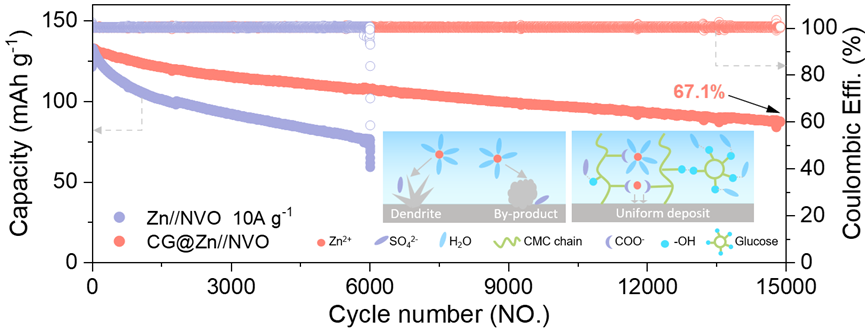As the installed capacity of clean energy continues to expand, the market demand for cost-effective energy storage technologies is growing day by day. Against this backdrop, aqueous zinc-ion batteries (AZIBs) stand out for their high safety, low-cost advantages, and environmentally friendly characteristics.
However, three major bottlenecks - dendrite growth, interfacial corrosion, and hydrogen evolution side reactions occurring at the zinc metal anode during cycling - cause a sharp decline in battery cycle life, hindering their commercial application. How to construct a stable zinc anode interface and achieve uniform Zn2+ deposition/dissolution has become a core challenge urgently requiring breakthroughs in this field.
In a study published in Journal of Colloid and Interface Science, the research group led by Prof. ZHANG Yining from Fujian Institute of Research on the Structure of Matter, Chinese Academy of Sciences, reported a bifunctional gel coating that significantly stabilizes the zinc anode interface and greatly enhances the cycle life of aqueous zinc-ion batteries (AZIBs).
The researchers developed this bifunctional gel coating (CG@Zn), which contains two components: sodium carboxymethyl cellulose (CMC) and glucose. The coating regulates Zn2+ transport through the carboxyl groups in CMC molecules, promoting the uniform distribution of Zn2+ at the zinc anode interface and effectively inhibiting dendrite formation.
Simultaneously, the hydroxyl-rich glucose molecules form hydrogen bonds to lock water molecules, significantly reducing the occurrence of hydrogen evolution reactions and enhancing the corrosion resistance of the zinc anode. The synergistic effect of CMC and glucose markedly improves battery performance.
At a current density of 5 mA cm-2, symmetric cells with the CG@Zn coating demonstrated stable cycling for over 1,000 hours—five times longer than bare zinc anodes. Full cells paired with a NaV3O8·1.5H2O cathode retained 67.1% capacity after 15,000 cycles at 10 A g-1, far outperforming uncoated counterparts.
Notably, the coating employs a water-based fabrication process, eliminating toxic solvents, while its biodegradable raw materials align with green chemistry principles.
This study provides a safe, high-performance solution for grid-scale energy storage and wearable electronics. The researchers has developed a 1 Ah pouch cell prototype achieving 1C@300 cycles, demonstrating strong commercialization potential.

Performance improvement of full cells with CG coating (Image by Prof. ZHANG's group).
Contact:
Prof. ZHANG Yining
Fujian Institute of Research on the Structure of Matter
Chinese Academy of Sciences
Email: ynzhang@fjirsm.ac.cn